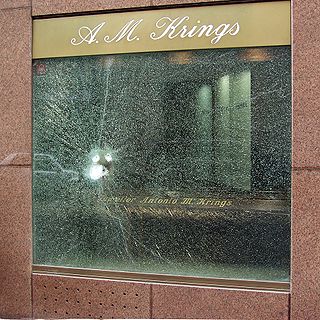Related Research Articles

A shaped charge is an explosive charge shaped to focus the effect of the explosive's energy. Different types of shaped charges are used for various purposes such as cutting and forming metal, initiating nuclear weapons, penetrating armor, or perforating wells in the oil and gas industry.

A kinetic energy penetrator (KEP), also known as long-rod penetrator (LRP), is a type of ammunition designed to penetrate vehicle armour using a flechette-like, high-sectional density projectile. Like a bullet or kinetic energy weapon, this type of ammunition does not contain explosive payloads and uses purely kinetic energy to penetrate the target. Modern KEP munitions are typically of the armour-piercing fin-stabilized discarding sabot (APFSDS) type.

Armour-piercing ammunition (AP) is a type of projectile designed to penetrate armour protection, most often including naval armour, body armour, vehicle armour.

Sintering or frittage is the process of compacting and forming a solid mass of material by pressure or heat without melting it to the point of liquefaction. Sintering happens as part of a manufacturing process used with metals, ceramics, plastics, and other materials. The nanoparticles in the sintered material diffuse across the boundaries of the particles, fusing the particles together and creating a solid piece.

A bulletproof vest, also known as a ballistic vest or a bullet-resistant vest, is an item of body armour that helps absorb the impact and reduce or stop penetration to the torso by firearm-fired projectiles and fragmentation from explosions. The vest may come in a soft form, as worn by many police officers, prison officers, security guards, and some private citizens, used to protect against stabbing attacks or light projectiles, or hard form, using metallic or para-aramid components. Soldiers and police tactical units wear hard armour, either in conjunction with soft armour or alone, to protect against rifle ammunition or fragmentation.

Chobham armour is the informal name of a composite armour developed in the 1960s at the British tank research centre on Chobham Common, Surrey. The name has since become the common generic term for composite ceramic vehicle armour. Other names informally given to Chobham armour include Burlington and Dorchester. Special armour is a broader informal term referring to any armour arrangement comprising sandwich reactive plates, including Chobham armour.

High-explosive anti-tank (HEAT) is the effect of a shaped charge explosive that uses the Munroe effect to penetrate heavy armor. The warhead functions by having an explosive charge collapse a metal liner inside the warhead into a high-velocity shaped charge jet; this is capable of penetrating armor steel to a depth of seven or more times the diameter of the charge. The shaped charge jet armor penetration effect is purely kinetic in nature; the round has no explosive or incendiary effect on the armor.

The cone penetration or cone penetrometer test (CPT) is a method used to determine the geotechnical engineering properties of soils and delineating soil stratigraphy. It was initially developed in the 1950s at the Dutch Laboratory for Soil Mechanics in Delft to investigate soft soils. Based on this history it has also been called the "Dutch cone test". Today, the CPT is one of the most used and accepted soil methods for soil investigation worldwide.

A ricochet is a rebound, bounce, or skip off a surface, particularly in the case of a projectile. Most ricochets are caused by accident and while the force of the deflection decelerates the projectile, it can still be energetic and almost as dangerous as before the deflection. The possibility of ricochet is one of the reasons for the common firearms safety rule "Never shoot a bullet at a flat, hard surface." Ricochets can occur with any caliber, but short or round ricocheting bullets may not produce the audible whine caused by tumbling irregular shapes. Ricochets are a hazard of shooting because, for as long as they retain sufficient velocity, ricocheting bullets or bullet fragments may cause collateral damage to animals, objects, or even the person who fired the shot.

Sloped armour is armour that is oriented neither vertically nor horizontally. Such angled armour is typically mounted on tanks and other armoured fighting vehicles (AFVs), as well as naval vessels such as battleships and cruisers. Sloping an armour plate makes it more difficult to penetrate by anti-tank weapons, such as armour-piercing shells, kinetic energy penetrators and rockets, if they follow a more or less horizontal trajectory to their target, as is often the case. The improved protection is caused by three main effects.

Bulletproof glass, ballistic glass, transparent armor, or bullet-resistant glass is a strong and optically transparent material that is particularly resistant to penetration by projectiles. Like any other material, it is not completely impenetrable. It is usually made from a combination of two or more types of glass, one hard and one soft. The softer layer makes the glass more elastic, so that it can flex instead of shatter. The index of refraction for all of the glasses used in the bulletproof layers must be almost the same to keep the glass transparent and allow a clear, undistorted view through the glass. Bulletproof glass varies in thickness from 3⁄4 to 3+1⁄2 inches.

Body armor, personal armor, armored suit (armoured) or coat of armor, among others, is protective clothing designed to absorb or deflect physical attacks. Historically used to protect military personnel, today it is also used by various types of police, private security guards, or bodyguards, and occasionally ordinary citizens. Today there are two main types: regular non-plated body armor for moderate to substantial protection, and hard-plate reinforced body armor for maximum protection, such as used by combatants.
Stopping power is the ability of a weapon – typically a ranged weapon such as a firearm – to cause a target to be incapacitated or immobilized. Stopping power contrasts with lethality in that it pertains only to a weapon's ability to make the target cease action, regardless of whether or not death ultimately occurs. Which ammunition cartridges have the greatest stopping power is a much-debated topic.
In fluid dynamics, the no-slip condition is a boundary condition which enforces that at a solid boundary, a viscous fluid attains zero bulk velocity. This boundary condition was first proposed by Osborne Reynolds, who observed this behaviour while performing his influential pipe flow experiments. The form of this boundary condition is an example of a Dirichlet boundary condition.
Handgun effectiveness is a measure of the stopping power of a handgun: its ability to incapacitate a hostile target as quickly and efficiently as possible.
The impact depth of a projectile is the distance it penetrates into a target before coming to a stop. The physicist Sir Isaac Newton first developed this idea to get rough approximations for the impact depth for projectiles traveling at high velocities.

Thermal barrier coatings (TBCs) are advanced materials systems usually applied to metallic surfaces on parts operating at elevated temperatures, such as gas turbine combustors and turbines, and in automotive exhaust heat management. These 100 μm to 2 mm thick coatings of thermally insulating materials serve to insulate components from large and prolonged heat loads and can sustain an appreciable temperature difference between the load-bearing alloys and the coating surface. In doing so, these coatings can allow for higher operating temperatures while limiting the thermal exposure of structural components, extending part life by reducing oxidation and thermal fatigue. In conjunction with active film cooling, TBCs permit working fluid temperatures higher than the melting point of the metal airfoil in some turbine applications. Due to increasing demand for more efficient engines running at higher temperatures with better durability/lifetime and thinner coatings to reduce parasitic mass for rotating/moving components, there is significant motivation to develop new and advanced TBCs. The material requirements of TBCs are similar to those of heat shields, although in the latter application emissivity tends to be of greater importance.

Armour-piercing fin-stabilized discarding sabot (APFSDS), long dart penetrator, or simply dart ammunition is a type of kinetic energy penetrator ammunition used to attack modern vehicle armour. As an armament for main battle tanks, it succeeds Armour-Piercing Discarding Sabot (APDS) ammunition, which is still used in small or medium caliber weapon systems.
Ceramic armor is armor used by armored vehicles and in personal armor to resist projectile penetration through its high hardness and compressive strength. In its most basic form, it consists of two primary components: A ceramic layer on the outer surface, called the "strike face," backed up by a ductile fiber reinforced plastic composite or metal layer. The role of the ceramic is to (1) fracture the projectile or deform the projectile nose upon impact, (2) erode and slow down the projectile remnant as it penetrates the shattered ceramic layer, and (3) distribute the impact load over a larger area, which can be absorbed by ductile polymer or metallic backings. Ceramics are often used where light weight is important, as they weigh less than metal alloys for a given degree of resistance. The most common materials are alumina, boron carbide, and, to a lesser extent, silicon carbide.

Freeze-casting, also frequently referred to as ice-templating, or freeze alignment, is a technique that exploits the highly anisotropic solidification behavior of a solvent in a well-dispersed slurry to controllably template a directionally porous ceramic. By subjecting an aqueous slurry to a directional temperature gradient, ice crystals will nucleate on one side of the slurry and grow along the temperature gradient. The ice crystals will redistribute the suspended ceramic particles as they grow within the slurry, effectively templating the ceramic.
References
- Lundberg, Patrik (2004). "Interface Defeat and Penetration: Two Modes of Interaction between Metallic Projectiles and Ceramic Targets" (PDF). Acta Universitatis Upsaliensis. Retrieved 2016-10-03.
{{cite journal}}: Cite journal requires|journal=(help)